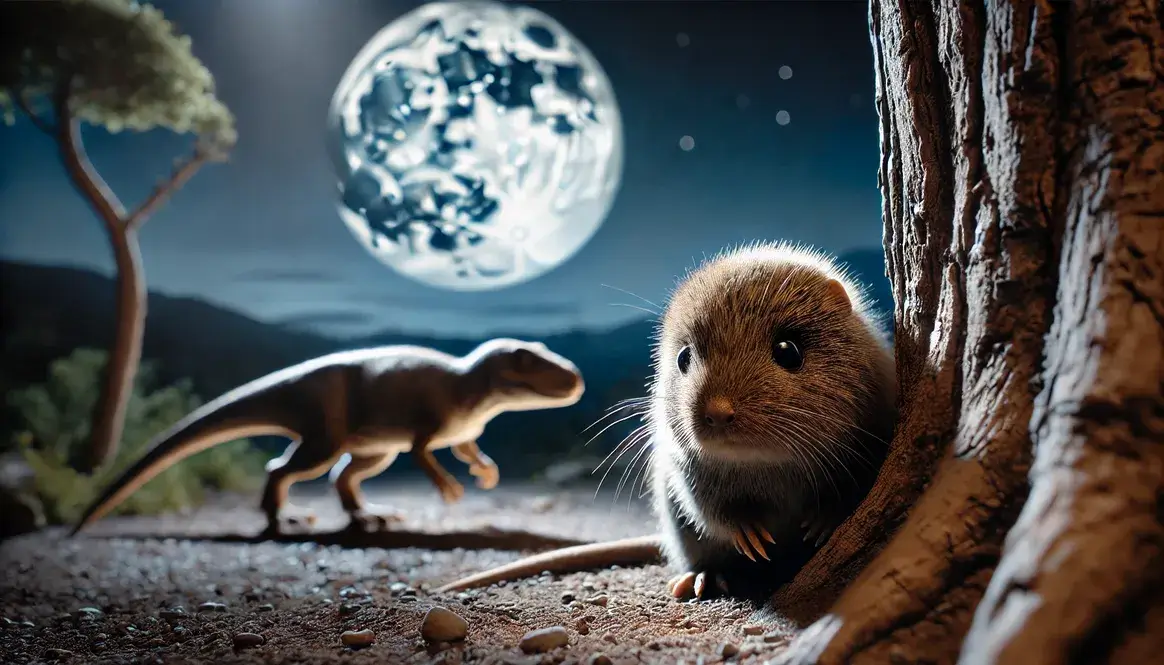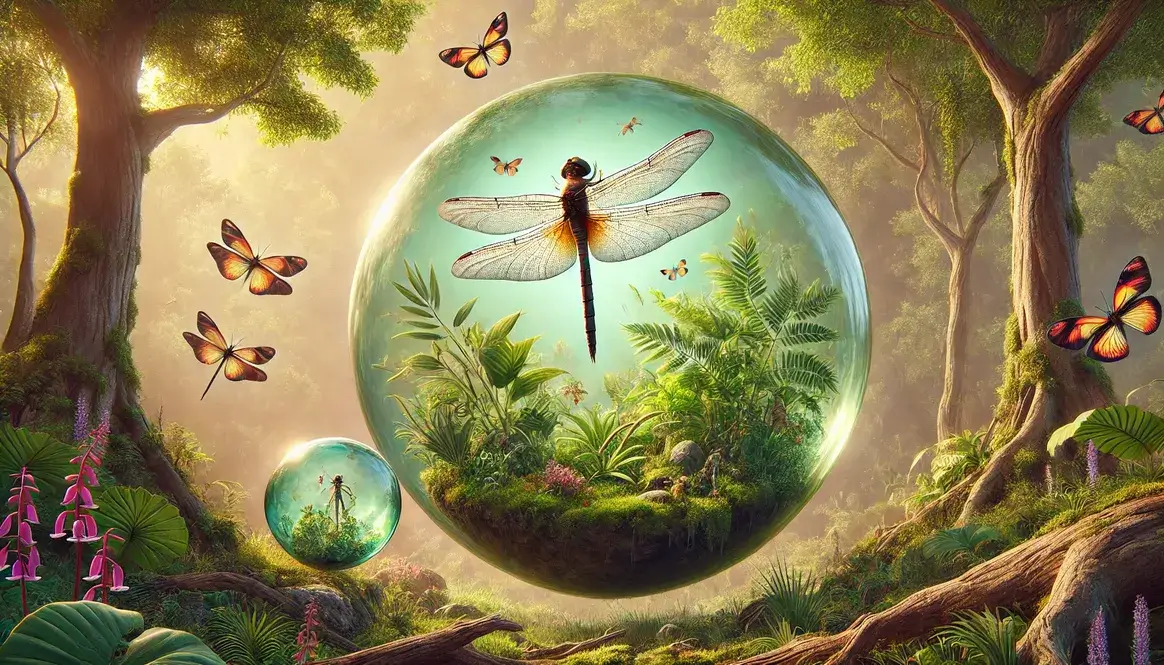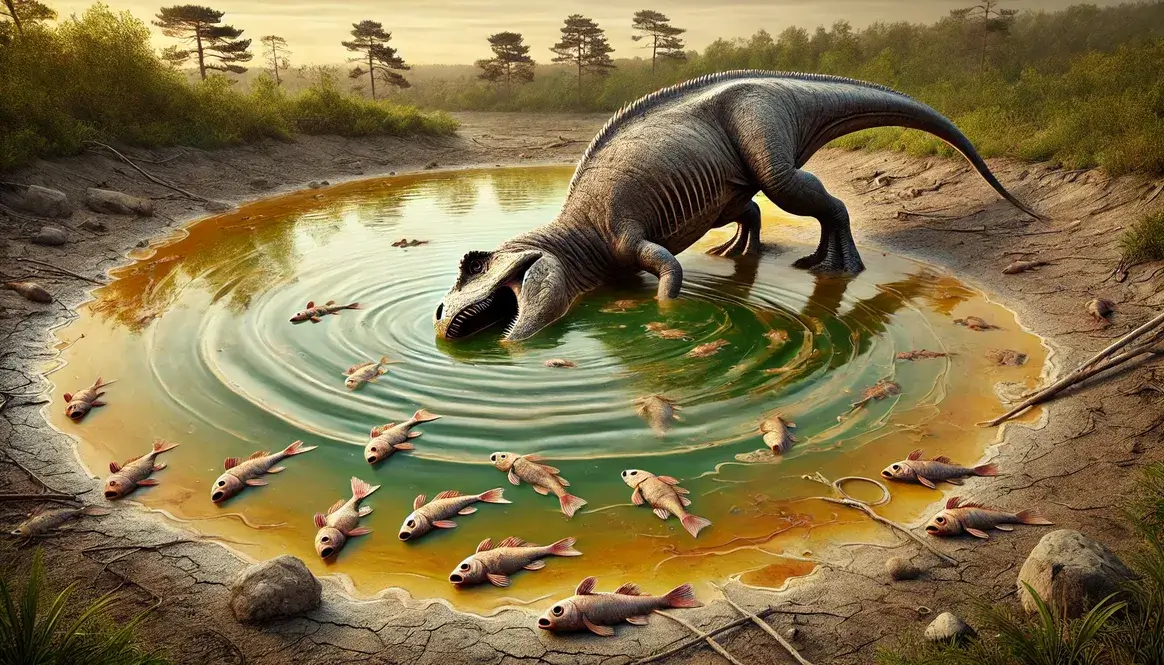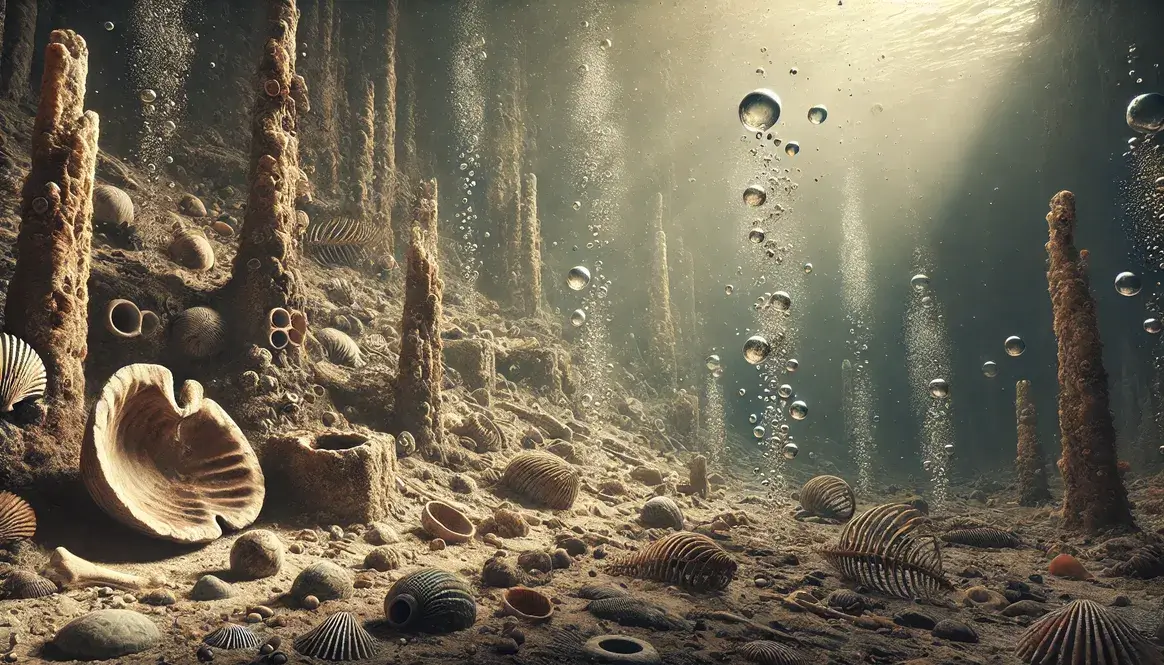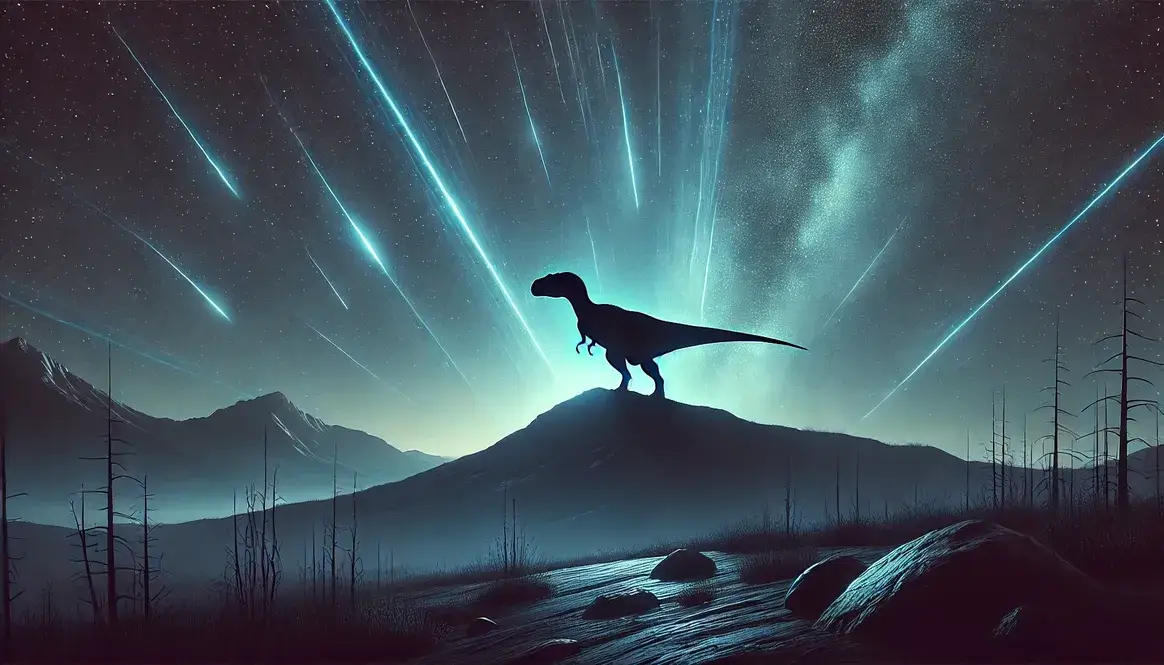Mammals and dinosaurs shared Earth for over 150 million years, but their relationship wasn’t simple. While dinosaurs ruled the daytime world, early mammals found creative ways to survive and thrive in their own spaces. The question “did mammals compete with dinosaurs?” has fascinated scientists studying ancient ecosystems. The answer changes depending on when in history we look.
| Time Period | Competition Level | Main Interactions | Mammal Survival Strategies |
|---|---|---|---|
| Early Mesozoic | Limited | Mostly avoidance | Small size, nocturnal habits |
| Mid-Mesozoic | Moderate | Shared resources | Specialized diets, different habitats |
| Late Cretaceous | Increased | Direct competition | Diverse adaptations, new niches |
| Post-extinction | None | Mammals filled empty niches | Rapid evolution, size increase |
The First Mammals and Dinosaurs
The story of mammals and dinosaurs begins in the Triassic Period, about 225 million years ago. During this time, the first mammals were tiny creatures, no bigger than modern shrews. They lived alongside the earliest dinosaurs, which were themselves relatively small compared to their later relatives.
Consider these size differences:
- Early mammals: Mouse to rat-sized (0.1-0.5 pounds)
- Early dinosaurs: Dog to horse-sized (20-1,000 pounds)
This size gap meant early mammals needed special ways to survive. They developed excellent hearing, a keen sense of smell, and warm-blooded bodies that helped them stay active at night when most dinosaurs rested. These early mammal ancestors found safety in being small and quick.
| Mammal Adaptations | Benefits for Survival |
|---|---|
| Warm-blooded metabolism | Active during cold nights |
| Fur covering | Temperature regulation |
| Excellent hearing | Detect predators early |
| Small size | Hide easily, need less food |
| Sharp teeth | Eat insects and small prey |
The first mammals survived by filling different roles in the environment than dinosaurs. While dinosaurs dominated the daylight hours, mammals became masters of the night. They found food in places dinosaurs couldn’t reach and ate things many dinosaurs ignored, like insects and seeds.
Did Mammals Compete with Dinosaurs? Early Evidence
The fossil evidence from mammals tells us an interesting story about how these early creatures managed to live alongside their much larger neighbors. Instead of trying to compete directly with dinosaurs, early mammals adapted to fill very different roles in their environment.
Scientists have found three main ways early mammals avoided competition:
- Time of Activity
- Active at night when dinosaurs slept
- Hunted during twilight hours
- Stayed hidden during peak dinosaur activity
- Living Spaces
- Underground burrows
- Tree hollows
- Dense undergrowth
- Food Choices
- Small insects
- Seeds and fruits
- Worms and grubs
Some of the most successful early mammals show just how creative these survival strategies were. The Repenomamus, for example, grew to the size of a modern badger and even ate small dinosaur hatchlings. Another mammal, Castorocauda, lived like today’s beavers, swimming in water where most dinosaurs couldn’t follow.
| Early Mammal | Size | Habitat | Diet |
|---|---|---|---|
| Repenomamus | Badger-sized | Ground-dwelling | Small vertebrates, eggs |
| Castorocauda | Beaver-sized | Semi-aquatic | Fish, aquatic insects |
| Volaticotherium | Squirrel-sized | Tree-dwelling | Flying insects |
| Hadrocodium | Mouse-sized | Ground-dwelling | Insects, worms |
These early mammals proved that sometimes the best way to handle competition isn’t to compete at all. By finding their own special places in the ancient ecosystems, they set the stage for the great diversity of mammals we see today.
Mid-Mesozoic Mammal Strategies
During the middle part of the Mesozoic era, mammals developed even more ways to live alongside dinosaurs. These strategies helped them find food and stay safe without competing directly with their larger neighbors.
Living in the Shadows
The darkness offered protection to mammals when most dinosaurs rested. Mammals developed special features for nighttime survival:
Nocturnal Adaptations:
- Large eyes for better night vision
- Long whiskers to feel their way around
- Sensitive ears to hear danger
- Strong sense of smell to find food
Being small came with surprising benefits. Small mammals needed less food and could hide almost anywhere. An animal the size of a mouse only needed to eat about 1/4 of its body weight each day, while large dinosaurs had to spend most of their time eating to survive.
| Size Advantage | Benefit |
|---|---|
| Less food needed | Easier to survive when food was scarce |
| More hiding spots | Better chance of escaping predators |
| Quick reproduction | Faster recovery of population numbers |
| Lower body heat | Easier to stay hidden from predators |
Underground homes provided safety for many mammals. These ancient burrow systems protected them from both predators and weather changes.
Finding Food Sources
Mammals found creative ways to get their food without competing with dinosaurs. Many specialized in eating insects, which were too small for most dinosaurs to bother with. The abundance of insects meant there was always food available.
Seeds became another important food source. While large plant-eating dinosaurs focused on leaves and branches, mammals could gather and store seeds for later use. This strategy worked especially well because:
- Seeds were highly nutritious
- They could be stored underground
- They were available year-round
- Most dinosaurs ignored them
Some brave mammals even became scavengers, sneaking bites from leftover dinosaur meals. They would wait until larger predators finished eating, then quickly grab what remained. This behavior required:
- Quick movements
- Good timing
- Excellent hearing
- Fast escape plans
These varied strategies show how mammals succeeded not by competing with dinosaurs, but by finding their own ways to thrive in a dinosaur-dominated world.
Late Cretaceous Mammal Diversity
By the Late Cretaceous period, when oxygen levels supported diverse life, mammals had grown more numerous and varied than ever before. The Cretaceous ecosystem changes opened new opportunities for different types of mammals to thrive.
Growing Variety
Mammals in the Late Cretaceous came in many different forms. Some remained tiny and tree-dwelling, while others grew larger and explored new ways of living. The fossil discoveries reveal an impressive range of mammal types:
| Mammal Type | Size | Lifestyle | Diet |
|---|---|---|---|
| Multituberculates | Rat-sized | Tree-dwelling | Seeds and fruits |
| Metatherians | Cat-sized | Ground-dwelling | Small prey |
| Eutherians | Dog-sized | Mixed habitats | Varied diet |
| Gondwanatherians | Rabbit-sized | Ground-dwelling | Plants |
New feeding strategies emerged as mammals developed different tooth types. Some specialized in:
- Crushing hard seeds
- Catching fish in streams
- Chewing tough plants
- Hunting smaller animals
Shared Resources
For the first time, clear evidence shows mammals and dinosaurs using the same resources. The food chain changes meant both groups sometimes competed for the same foods and spaces.
Scientists have found proof of this competition in several ways:
- Tooth marks on the same types of seeds
- Similar wear patterns on teeth
- Shared nesting areas
- Overlapping territory markers
One fascinating example comes from Mongolia, where mammals and small dinosaurs used the same burrow systems for shelter. These underground spaces show signs that both groups lived there at different times, marking the first clear evidence of direct habitat competition.
The growing boldness of mammals meant they no longer just avoided dinosaurs. Some larger mammals even challenged smaller dinosaurs for food and territory. This marked a significant change from their earlier “hide and survive” strategy to a more direct form of competition.
Yet most mammals still kept to their specialized niches. While they might share some resources with dinosaurs, they maintained many of their successful survival strategies from earlier times. This balance would continue until major changes arrived at the end of the Cretaceous period.
Evidence of Competition
The fossil record provides clear signs of interaction between mammals and dinosaurs. Scientists studying these ancient remains have uncovered fascinating evidence of how these animals shared their world.
Fossil Clues
Fossil remains tell stories about how mammals and dinosaurs interacted. Tooth marks found on bones show that some mammals ate dinosaur eggs and hatchlings. These marks are different from those left by other dinosaurs, proving that mammals sometimes hunted young dinosaurs.
Near the end of the Cretaceous period, both groups left signs at the same places:
Shared Space Evidence:
- Footprints crossing the same areas
- Burrows used by both groups
- Nesting materials mixed together
- Feeding marks on the same plants
The ancient soil layers contain seeds and nuts with tooth marks from both mammals and dinosaurs. This shows they sometimes ate the same foods, proving direct competition for resources.
Size Comparisons
| Animal Type | Size Range | Example Species | Main Diet |
|---|---|---|---|
| Largest Mammals | Dog-sized | Repenomamus | Small vertebrates |
| Smallest Dinosaurs | Chicken-sized | Compsognathus | Insects, lizards |
| Medium Mammals | Cat-sized | Didelphodon | Shellfish, eggs |
| Small Dinosaurs | Turkey-sized | Velociraptor | Small prey |
The size gap between mammals and dinosaurs wasn’t always huge. While the largest dinosaurs were enormous, some of the smallest dinosaur species weren’t much bigger than the largest Cretaceous mammals.
This size overlap meant some mammals and dinosaurs hunted the same prey and lived in similar places. The largest known Cretaceous mammal, Repenomamus, reached sizes similar to the smallest dinosaurs of its time. Fossil evidence shows it even ate young dinosaurs, proving that competition went both ways.
Scientists have found bones of both groups preserved together in the same locations, suggesting they lived in the same areas and competed for resources. These discoveries show that while most mammals avoided direct competition with dinosaurs, some brave species actively competed for food and territory.
After the Extinction
When dinosaurs disappeared at the end of the Cretaceous period, mammals faced a world of new opportunities. The K-Pg extinction event changed everything about life on Earth.
Empty Spaces
After the extinction, many ecological niches became available:
- Large plant-eater roles
- Top predator positions
- Daytime hunting spots
- Open ground habitats
The surviving plant species provided food for plant-eating mammals. Without large dinosaurs eating them, plants grew more abundantly. This created new opportunities for mammals to eat different types of vegetation.
| Former Dinosaur Role | New Mammal Examples |
|---|---|
| Large herbivore | Early elephants |
| Top predator | Early big cats |
| Tree browser | Early primates |
| Ground grazer | Early horses |
Mammal Growth
Once dinosaurs disappeared, mammals underwent amazing changes. The earliest mammal ancestors that survived the extinction quickly began to grow larger and explore new ways of living.
These changes happened because:
- More food was available
- No large predators existed
- New habitats opened up
- Daytime activities became safer
Mammals developed new hunting methods too. Without competing predators, they could hunt during the day and in open areas. Some grew larger and stronger, while others became faster runners. Each group found its own special way to succeed.
The most dramatic change was how mammals spread into roles once held by dinosaurs. Some grew to massive sizes, becoming the new giants of their world. Others remained small but moved into new habitats. This variety led to the wide range of mammals we see today.
The end of dinosaur dominance marked the beginning of the Age of Mammals, a time when these once-small creatures would evolve into thousands of different species, from tiny shrews to enormous whales.
What We Learned About Ancient Competition
The question “did mammals compete with dinosaurs?” has a complex answer that changed through time. Early mammals mostly avoided competition through clever adaptations. As time passed, some braver species began competing directly with smaller dinosaurs. But the real story of mammal success isn’t about competition – it’s about finding unique ways to survive. By staying small, being active at night, and eating different foods, mammals proved that sometimes the best strategy isn’t to compete, but to find your own path. When dinosaurs disappeared, mammals were ready to expand into new roles, leading to the incredible variety of mammals we see today. This pattern shows nature’s remarkable ability to find balance, even between very different groups of animals.
| Competition Phase | Main Strategy | Result |
|---|---|---|
| Early Mesozoic | Avoidance | Survival in different niches |
| Late Cretaceous | Limited competition | Increased diversity |
| Post-extinction | Expansion | Mammal dominance |

